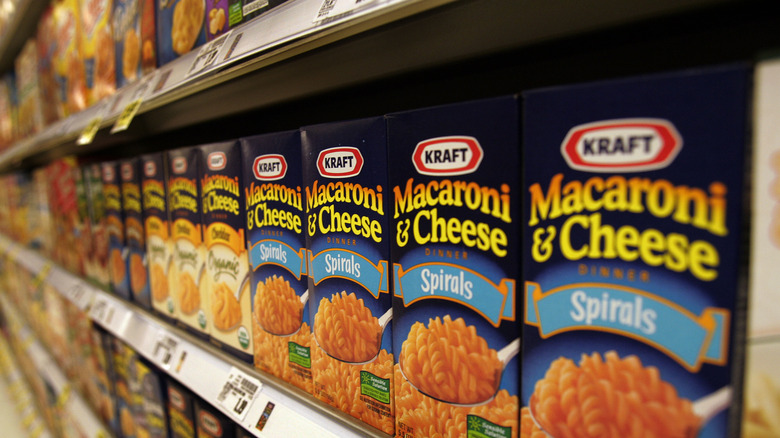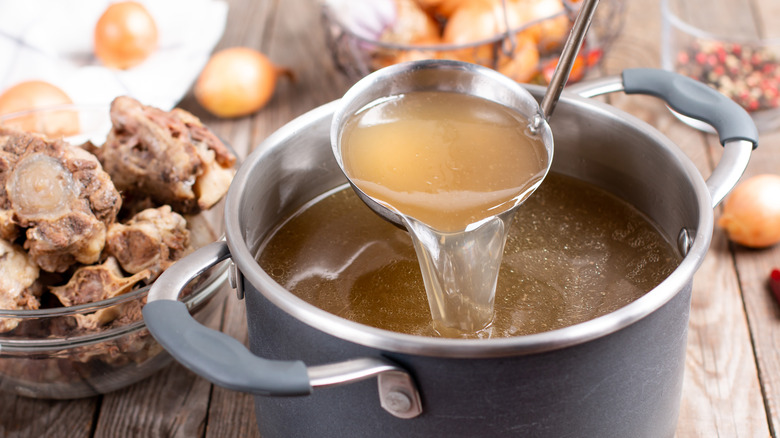The Secret Ingredient You Need To Give Your Mac And Cheese An Umami Kick
You've gotta hand it to boxed mac and cheese, because even when the cupboards are bare, you've always have a meal as long as you have a box or two on the shelf. When it's made strictly following the directions on the back, a box of macaroni and cheese is somehow always satisfying no matter how old you are. If you're tired of the same old mac, however, there's a world of flavor options that can take your Kraft dinner to the next level. You don't even need to shop for special ingredients to jazz up a standard box of shells and cheese because you've already got plenty of great flavors sitting right in your own refrigerator. If you want to give your cheesy pasta a major umami kick, for example, cook the pasta with some bone broth or stock.
Cooking your pasta with broth or stock is perfect for macaroni and cheese because the sauce isn't particularly heavy. The earthy flavor will give your ordinary store-bought mac an extra layer of depth. Your pasta will absorb some of the rich, savory flavor without adding an overwhelming meaty taste, and when you mix it with the cheese sauce you'll get a next-level bowl of pasta.
Any broth will do
You can use almost any type of stock or bone broth you have on hand to boil your mac and cheese noodles, including vegetable, chicken, beef, or even seafood. All you need to do is swap out half the amount of water you'd use to boil the pasta with your stock or broth. Because stock is a little more precious than water, read the package instructions and use the recommended amount of liquid rather than just eyeballing it. You don't want to waste your stock, and you also want to make sure that you don't dilute the liquid so much that you can't taste it in the pasta. Depending on your preferred brand of mac and cheese, the directions usually call for six to eight cups of water for boiling, so plan to have three or four cups of stock or broth. If you're buying broth from the grocery store, a box of broth is 32 fluid ounces, which is four cups of stock, so secure yourself one box of broth for every box of pasta.
If you prefer to use bullion cubes or a concentrated stock base instead of full-volume broth or stock, measure your ratio of base-to-water to be a little more watery than normal because these options tend to have a saltier profile, resulting in a super-salty tasting pasta if you go overboard.
Build your flavor profile
If you're feeling a little more adventurous, try adding even more ingredients to build up your mac and cheese feast based on whatever stock you're using to boil the pasta. For instance, if you're using chicken bone broth, you can add some cut-up rotisserie chicken and veggies to your finished pasta for a chicken à la king-style mac. If you happen to be using seafood stock, you can add some sauteed shrimp and parmesan cheese to the mix for an easy seafood alfredo.
If you want to get extra experimental, try saving some of the brothy water and using your mac and cheese to make a savory soup. Add some protein, like shredded chicken, frozen peas or spinach, and a few shakes of Italian seasoning. Then, thin out the mac and cheese mix with some of your reserved pasta/broth water until you reach a soup consistency. If you prefer a creamy soup, mix a tablespoon of flour with some of the cooled broth to make a slurry and then whisk it in, bring the mixture to a boil, and it'll thicken right up.
Once you start experimenting with your macaroni and cheese you'll stop seeing it as just a convenience food and start looking at it as a blank slate for all kinds of tasty, creative, and inexpensive future dinners.


